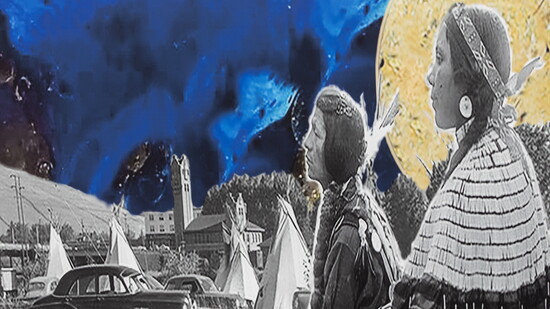Next time you’re waiting at a stoplight in Missoula, look around for a decorated box. Perhaps you’ve spotted the popcorn machine at the corner of Mullan and West Broadway or the herd of neon horses just a few blocks down near Russell. However, if you’ve never noticed those boxes until they were decorated, you’re not alone. These traffic signal boxes (TSBs) have been transformed from unremarkable, government green utilities to pieces of art since 2008.
“We started out with 72 boxes,” said Kathi Olson, head of Missoula’s Public Art Committee. Kathi credits Paula Goldberg, the artist behind the popcorn machine, for the inspiration to start the project. “She came to me and said, ‘We do these in my hometown in Missouri, and we should do it in Missoula.’ So, we brought the idea before the city’s Public Art Committee, and they voted it in. Then, we had to take it to the highway department and any public entities involved with the boxes. They saw the benefits and gave approval shortly after,” Kathi said. Since then, all of the entities involved have been quick to approve new artwork for more boxes each year. The decision is easy, given that decorating the boxes has shown to decrease graffiti by 90%. “I think people respect the artists’ work,” said Kathi.
The artwork’s visual impact is one aspect considered by the committee when selecting artists, but how that design will mesh with the box’s structure is important. So, in addition to the application, artists must complete a 3D model of their design. “We’ve found that part to be crucial,” said Kathi. “When someone sees how their work will wrap around the box and has to incorporate elements like ventilation slats and access doors, they have a chance to adapt their design.” Even though artwork must be customized to the boxes, the committee encourages applications from all types of artists working in any medium. “If you’re a painter, you can paint directly on the boxes. Sculptors and photographers can take pictures of their work and transfer that to a vinyl wrap. Digital creations transfer to vinyl easily, as well,” she said.
When enough boxes are ready for a makeover, the city’s Public Art Committee sends out an art call and gathers people with a wide range of interests to help select the winners. “The committee is inclusive,” explained Kathi. “Before we put out an art call, we meet with people and businesses in the neighborhood to invite them into the selection process. And, of course, representatives from multiple public entities are included to guarantee that any type of decoration won’t harm the functioning of the boxes.”
This year marks the 40th anniversary of the creation of Missoula’s Public Art Committee (originally established by Mayor Toole). The committee is charged with “developing a collection of public art that is of the highest quality, that encompasses a broad aesthetic range reflecting the city and its citizens, improves the quality of life in the area, accessible to all individuals, and is a source of pride to all residents.” “The TSB project has worked well for that,” said Kathi. “It’s also a chance for artists to understand the public art process and decide if they want to get involved with more public installations. Public art is different from gallery-style art. There’s the aesthetics, but there’s also public health and safety to consider. There are more parameters artists have to adhere to,” she said.
Funding for public art often comes from several different sources, and the TSB project is no exception. The majority of funds come from private donations (often from people living in the neighborhoods near each box). In addition, neighborhood grants and redevelopment funds help to make up the difference, so the committee can pay a meaningful award to each artist for their work. Fitting those pieces of the financial puzzle together, along with the enduring chutzpah of the Public Art Committee members, has kept the project going for 17 years. In fact, other Montana towns look to Missoula as a model for creating their own box programs. “We’ve helped five to 10 communities a year; most in Montana but some across the country, as well,” said Kathi.
To transform a drab public utility box into a work of art seems apropos for Missoula, where we imbue our public spaces with creativity. “Artists have been out there, under tents, creating their artwork in rain, sleet, and snow. People will drive by and honk their horns in encouragement. I’ve seen many a dad bring their child soup,” said Kathi. With dedicated volunteers behind the scenes and resilient artists on the corners making their visions into reality, Missoula drivers have a pleasant surprise to enjoy while waiting at an otherwise boring red light. You can see pictures of all the boxes at PublicArtMissoula.org/traffic-signal-boxes.
"The decision is easy, given that decorating the boxes has shown to decrease graffiti by 90%. I think people respect the artists’ work." Kathi Olson
